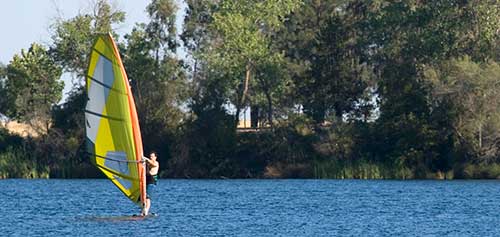Staying safe when you're outdoors
We encourage you to visit our recreational areas and enjoy the great outdoors all year long. Whether you're biking, hiking, swimming, sailing or fishing, we want to keep our community safe.
Water safety
Recreation safety when boating or swimming
The Sacramento area has some great rivers and lakes. We want you to enjoy these 
- Wear personal flotation devices (PFDs) like a life jacket. Most drowning victims would be alive today if they had.
- Insist that all boat passengers wear Coast Guard-approved PFDs or flotation garments.
- Avoid mixing alcoholic beverages with swimming, fishing and boating.
- If you are a boat owner, participate in a boating safety class. At a minimum, here are a few things you want to be able to do as a boat owner:
- Learn how to enter the water properly, falling backwards while covering nose and mouth with hand.
- Practice a safety back float with all your clothes on.
- Enroll in a Red Cross, YMCA or community recreation program that teaches basic swimming skills.
- Practice using throw-line bags, ring buoys and other flotation aids with your family.
- Become familiar with the four behaviors associated with a drowning victim: head back, mouth open, flailing arms and no sound.
- Discuss hypothermia and its effects during an unexpected immersion.
- Practice survival strategies before your life depends on them.
- Automobile passengers are at best advantage if they have seat belts on when their car enters the water. Seat belts limit personal trauma, help keep the victim in a familiar location and keep the victim conscious so they can determine how to get out.
- Most alert, conscious victims can open car doors and windows under water or push out the windshield at a corner.
- Panic is the swimmer's worst enemy. Relax and work with the water in a logical plan.
This information is provided by SMUD and DART, the Drowning Accident Rescue Team. For more information, contact DART at 1-916-732-4500.
Stream flow and reservoir conditions
Get information about the Streamflow Release Schedule for whitewater boating. You can also view stream flows and reservoir elevations to see if conditions are right for your planned outings.

Kite flying safety
Do's:
- Build or fly kites made of wood or plastic. Use cloth for the tail.
- Fly kites in wide open areas, away from power lines.
- Use cotton, linen or nylon string. Metallic thread, wire or wire-reinforced string can cause serious injury or death if they come in contact with energized equipment.
- Fly kites in dry weather. Wet kite string is a strong conductor of electricity.
- For more kite flying safety tips and interesting aerodynamic experiments visit the NASA website.
Don'ts:
- Never fly your kite around power lines or substation facilities.
- Avoid flying kites around trees or towers.
- Never release metallic balloons near electrical lines.
- Avoid climbing trees or using ladders in trees to retrieve kites. Serious injury can occur.
- Don't let children play or climb on wooden utility poles, metal transmission towers or any trees that may bring them into contact with power lines.
Kite stuck in a power line? Call us.
If a kite gets caught in electrical lines or falls into a substation, leave it there. Do not touch any part of the kite or string. Call us at 1-888-742-7683 and a SMUD employee will be able to safely retrieve it.
Other recreational safety tips:
- Never cast fishing lines under power lines.
- Avoid flying model airplanes near power lines.



